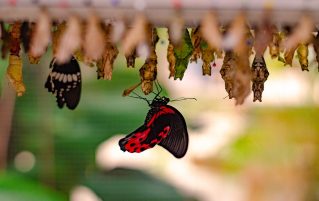

Eukaryotic cells can look very different from each other, depending on what their function is. Cells will become specialised, have a wide range of different jobs, and behave in many ways.
Have you ever wondered why tattoos are permanent? The outer layer of your skin is made up of epidermal cells, and these shed all the time. For this to happen, the ink has to travel through this layer to the dermis cells underneath. The skin is pierced by needles. Each time the needle penetrates, it is a trigger for our immune system to respond. Specialised white blood cells, known as macrophages move to the site of the wound and try to “engulf” the dye. However, the ink particles can be far too big for them to engulf and destroy. Therefore they absorb them and keep them in the dermis, where we can see them!
When a caterpillar transforms its body inside a chrysalis – it is actually digesting itself. It does this by releasing enzymes to break down its tissues. However, specialised groups of cells survive. These use the protein rich “caterpillar soup” to build the new adult parts of the butterfly. Chameleons are able to change colour by rearranging melanin, and other pigments in cells. These pigments are found in layers of specialised cells in the skin. This happens in response to hormones, sometimes for camouflage, but also patterns can emerge with stripes or spots which signal the chameleon’s mood

If you are in Year 7 or above, you need to be able to recognise different specialised cells. You should also be able to label some of these and explain how they are adapted to their function.
To help you understand, check out Part 2 of our “How to work with Cell Biology” guide. This describes the structure of different cells, and how they are adapted. It also includes some GCSE questions for you to practice, and answers to check your understanding.
Click on the picture below to see the guide.
If you found this useful and think you would benefit from some additional help please contact us.
We welcome guest bloggers.
